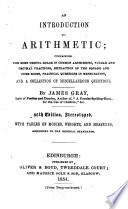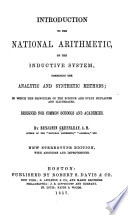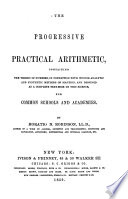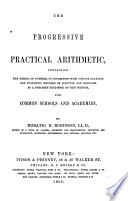 | James Gray - Arithmetic - 1854 - 120 pages
...which a debt due at dif. ferent times may be discharged at once, without disadvantage to either party. RULE. Multiply each payment by the time at which it is due ; divide the вит of the products by the amount of tho debt : the quotient is the time required.... | |
 | Charles Davies, William Guy Peck - Mathematics - 1855 - 628 pages
...is as follows : Multiply each payment by the time before it becomes due, and divide the sum of these products by the sum of the payments : the quotient will be the mean time. Let it be required to find the mean time of payment of a sum of S200 due in two months,... | |
 | Roswell Chamberlain Smith - Arithmetic - 1856 - 334 pages
...I. RKCIPBOCATS, [L. r«iPrtetia.] To exchange ; to interchange; to give and return mutually. several products by the sum of the payments ; the quotient will be the mean 01 equitable time for the payment of the whole.* 11. A owes B $200 to be paid in 6 months, $300... | |
 | Joseph Ray - Arithmetic - 1857 - 348 pages
...COMMON RULE FOR EQUATION OP PAYMENTS. Multiply each payment by the time to elapse till it becomes due; divide the sum of the products by the sum of the payments ; the quotient will be the equated time. When one of the payments is due on the day from which the equated time is reckoned, its product is... | |
 | Charles Guilford Burnham - 1857 - 342 pages
...months, 75-7-15 = 5 months, the answer. Hence the RULE. Multiply each payment by the time when it becomes due, and divide the sum of the products by the sum of the payments, and the quotient will be the time required. 2. A merchant has owing him $420, to be paid as follows... | |
 | Charles Guilford Burnham - Arithmetic - 1857 - 328 pages
...5-4-15 = 5 months, the answer. Hence the ' RULE. Multiply each payment by the time when it becomes due, and divide the sum of the products by the sum of the payments, and the quotient will be the time required. 2. A merchant has owing him $420, to be paid as follows... | |
 | Benjamin Greenleaf - Arithmetic - 1857 - 336 pages
...payment of the whole. Hence the following RULE. — Multiply each payment by its own time of credit, and divide the sum of the products by the sum of the payments. NOTE 1. — This is the rule usually adopted by merchants, hut it is not perfectly correct ; for if... | |
 | Horatio Nelson Robinson - Arithmetic - 1859 - 352 pages
...of 6 months on $30, because 30 X 6= 180 X 1. RULE. I. Multiply each payment by its term of credit, and divide the sum of the products by the sum of the payments ; the quotient will be the average term of credit. II. Add the average term of credit to the date at which all the credits begin,... | |
 | Horatio Nelson Robinson - Arithmetic - 1859 - 348 pages
...because 30 X 6 = 180 X 1. RULE. I. Multiply each payment by its term of credit, and divide tfie sum of the products by the sum of the payments ; the quotient will be the average term of credit. Average term of credit. Equated time. Give Case I. Analysis. Rule. II. Add... | |
 | Horatio Nelson Robinson - Arithmetic - 1860 - 444 pages
...because 45 X 00 = 270 X 1. Hence the following RULE. I. Multiply each payment by its term of credit, and divide the sum of the products by the sum of the payments; the quotient will be the average term of credit. II. Add the average term of credit to the date at which all the credits begin;... | |
| |